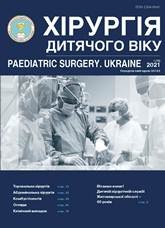Staged surgical management of anorectal atresia associated with type II colon atresia and urinary system anomalies in a newborn boy (case report and literature review)
DOI:
https://doi.org/10.15574/PS.2021.70.54Keywords:
anorectal atresia without fistula, sigmoid atresia, vesicoureteral reflux, coronary hypospadias, surgical management, newborn boyAbstract
Anorectal malformation is a congenital anomaly and can be either isolated or associated. This malformation is often combined with other congenital defects, in particular VACTERL-association (anomalies of the spine, anal region, heart, trachea, esophagus, kidneys and extremities), which requires a comprehensive diagnosis in these patients.
Congenital malformations of the gastrointestinal tract except for esophageal atresia are rare. The paper presents a clinical case of associated congenital anomalies of the gastrointestinal tract and urinary system in a newborn boy: congenital anorectal malformation without fistula, type II sigmoid atresia with bowel malrotation, vesicoureteral reflux, right-sided pyelectasia and coronal hypospadias. Comprehensive diagnostics before each stage of surgical treatment made it possible to determine the method and technique of surgical correction. This made it possible to preserve a part of the intestine which was presented in the form of an enterocyst to create a neorectum as well as to diagnose the functional incompetence of the preatritic segment of the colon and carry out its removal.
Atresia of the sigmoid colon is not a common concomitant malformation in congenital anorectal malformation, but it should be taken into account in the differential diagnosis in newborns with progressive abdominal distension and anorectal atresia without fistula. The proposed staging of the surgical management of these associated malformations should be regarded as organ-preserving, allowing to restore the normal function of the gastrointestinal tract and urinary system, with a good functional result.
The research was carried out in accordance with the principles of the Helsinki Declaration. The study protocol was approved by the Local Ethics Committee of these Institutes. The informed consent of the patient was obtained for conducting the studies.
The authors declare no conflicts of interests.
References
Chadha R. (2006). Treatment strategies in the management of jejunoileal and colonic atresia. J Indian Assoc Pediatr Surg. 11 (2): 79-84. https://doi.org/10.4103/0971-9261.25929
ChiehTeng Hsu. (2010). Congenital colonic atresia: report of one case. J Pediatr Neonatol. 51 (3): 186-189. https://doi.org/10.1016/S1875-9572(10)60035-6
Chouikh T. (2014). Congenital colonic atresia: 4 case reports. J Pediatr Neonatal Care. 1 (3): 14. https://doi.org/10.15406/jpnc.2014.01.00018
Cox SG. (2005). Colonic atresia: spectrum of presentation and pitfalls in management. A review of 14 cases. Pediatr Surg Int. 21 (10): 813-818. https://doi.org/10.1007/s00383-005-1488-4; PMid:16133521
Davenport M. (1990). Colonic atresia: current results of treatment. J R Coll Surg Edinb. 35 (1): 25-28.
Draus JM. (2007). Hirschsprung's disease in an infant with colonic atresia and normal fixation of the distal colon. J Pediatr Surg. 42 (2): 5-8. https://doi.org/10.1016/j.jpedsurg.2006.10.021; PMid:17270533
Ein SH. (1997). Imperforate anus (anal agenesis) with rectal and sigmoid atresias in a newborn. Pediatr Surg Int. 12 (56): 449-451. https://doi.org/10.1007/BF01076966; PMid:9244126
ElAsmar KM. (2016). Colonic atresia: association with other anomalies. J Neonatal Surg. 5 (4): 47. https://doi.org/10.21699/jns.v5i4.422; PMid:27896155 PMCid:PMC5117270
Etensel B. (2005). Atresia of the colon. J Pediatr Surg. 4 (8): 1258-1268. https://doi.org/10.1016/j.jpedsurg.2005.05.008; PMid:16080929
Gobran T. (2013). Different varieties of colonic atresia in a series of 13 patients: a single-center experience. Annals Pediatr. Surg. 9 (1): 20-24. https://doi.org/10.1097/01.XPS.0000422584.90713.92
Goodwin S. (2006). Imperforate anus and colon atresia in a newborn. J Pediatr Surg. 41: 583-585. https://doi.org/10.1016/j.jpedsurg.2005.11.055; PMid:16516641
Imran M. (2009). Sigmoid atresia: a rare cause of neonatal intestinal obstruction. Kust Medical Jornal. 1 (2): 71-72.
Lautz Т. (2015). VACTERL associations in children undergoing surgery for esophageal atresia and anorectal malformations: Implications for pediatric surgeons. J Pediatr Surg. 50: 1245-1250. https://doi.org/10.1016/j.jpedsurg.2015.02.049; PMid:25913268
Levard G. (1990). Congenital colonic atresia: which surgery to use? Chir Pediatr. 31 (6): 289-294.
Moufidath S. (2018). Anorectal malformation without fistula in female neonate and colonic atresia: a rare association. Clinics Mother Child Health. 15 (4): 1-2. https://doi.org/10.4172/2090-7214.1000304
Petropoulos AS. (2004). Imperforate anus associated with atresia of the transverse colon: a case report. Eur J Pediatr Surg. 14 (4): 290-292. https://doi.org/10.1055/s-2004-815878; PMid:15343473
Pohlson EС. (1988). Individualized management of colonic atresia. Am J Surg. 155 (5): 690-692. https://doi.org/10.1016/S0002-9610(88)80146-6
Powell RW. (1982). Congenital colonic atresia. J Pediatr Surg. 17 (2): 166-170. https://doi.org/10.1016/S0022-3468(82)80203-0
Pykaliuk VS. (2011). Filo-, ontohenez orhaniv i system liudyny. Simferopol: 312.
Saha M. (2016). Alimentary tract atresias associated with anorectal malformations: 10 years' experience. J Neonatal Surg. 5 (4): 43. https://doi.org/10.21699/jns.v5i4.449; PMid:27896151 PMCid:PMC5117266
Singh V. (2016). Congenital neonatal intestinal obstruction: retrospective analysis at tertiary care hospital. J Neonatal Surg. 5 (4): 49. https://doi.org/10.21699/jns.v5i4.393; PMid:27896157 PMCid:PMC5117272
Downloads
Published
Issue
Section
License
The policy of the Journal “PAEDIATRIC SURGERY. UKRAINE” is compatible with the vast majority of funders' of open access and self-archiving policies. The journal provides immediate open access route being convinced that everyone – not only scientists - can benefit from research results, and publishes articles exclusively under open access distribution, with a Creative Commons Attribution-Noncommercial 4.0 international license(СС BY-NC).
Authors transfer the copyright to the Journal “PAEDIATRIC SURGERY.UKRAINE” when the manuscript is accepted for publication. Authors declare that this manuscript has not been published nor is under simultaneous consideration for publication elsewhere. After publication, the articles become freely available on-line to the public.
Readers have the right to use, distribute, and reproduce articles in any medium, provided the articles and the journal are properly cited.
The use of published materials for commercial purposes is strongly prohibited.

